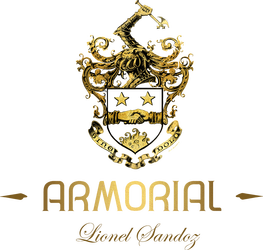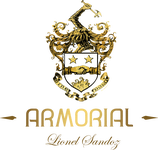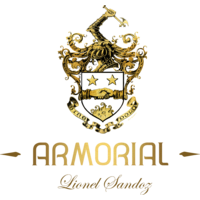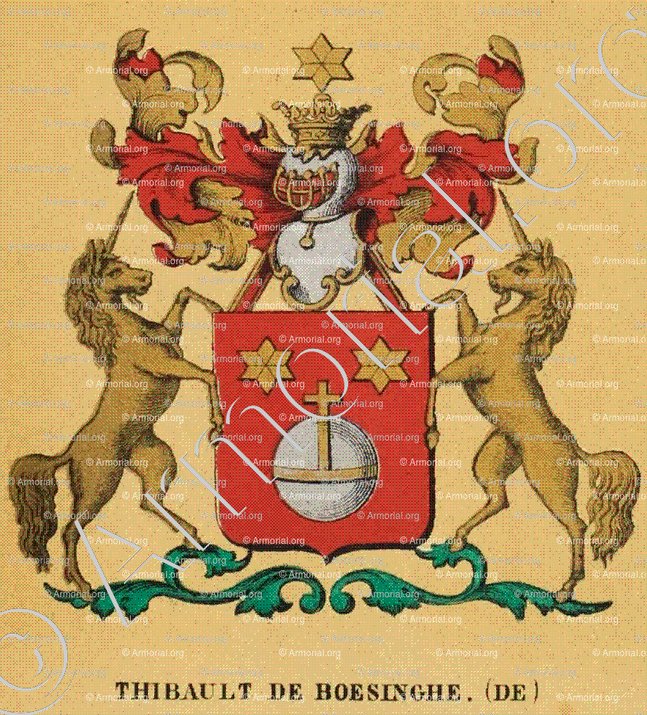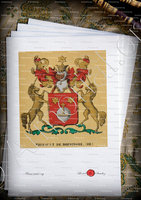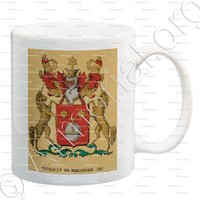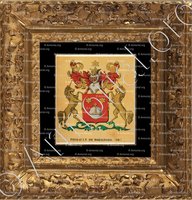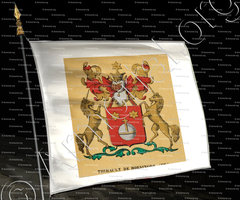DESCRIPTION
THIBAULT de BOESINGHE
Bruges
Flandre occidentale
Belgique
Armoiries :
" De gueules au monde d'argent cintré et croiseté d'or, accompagné, en chef, de deux étoiles à 6 rais du même. "
- L'écu timbré d'un casque d'argent grillé, liseré et colleté d'or, couronné (de fantaisie) du même . (1), fourré et attaché de gueules, assorti de ses lambrequins de gueules et d'or .
- Cimier : une étoile de l’écu.
- Supports : deux licornes affrontées d'or.
(1) Cette couronne est commune à tous les chevaliers du Saint Empire Romain.
Sources :
- Armorial de Bruges par un membre de l'Académie royale et nationale d'archéologie et de géographie d'Espagne, 1863.
- Messager des sciences et des arts, publié par la Société royale des beaux-arts et des lettres, et par celle d'agriculture et de botanique de Gand, par Messager des sciences historiques, 1824.
- Catalogue des livres et manuscrits composant la bibliothèque héraldique et généalogique d'Ernest de Roziere etc .. par Ernest de Roziere, 1879.
Note historique et biographique : THIBAULT de BOESINGHE
Ces armes sont dessinées conformément aux lettres patentes de la famille de Thibault, modifiées en vertu des articles 558 et 559 du code du blason.
Les lettres patentes de la famille de Thibault de Boesinghe blasonnent l’écu précité.
Le texte dit : " de gueules au globe... cerclé ... et le pinceau représente « une carte géographique circulaire bordée ou liserée d'or . »
Le globe terrestre est fort héraldique, mais : 1°, jamais il ne porte des dessins géographiques; 2°. toujours il est cintré ; le cintre est nécessaire pour marquer qu'il y a sphère et non cercle ; un globe ne peut être cerclé parce qu'en armoiries tout corps cerclé est plan.
Il faut donc un monde à cintre et à croisette.
Le nom de Thibault est fort ancien : à la fois patricien et noble, il brille dans les annales de la magistrature yproise, presque à partir de l'émancipation des communes.
Outre les armoiries blasonnées en tête de cette notice, nous trouvons, sous le nom des Thibault, les deux écus qui suivent :
" 1° d'azur à la fasce d'argent accompagnée, en chef, de deux étoiles à 6 rais et, en pointe, d'un chevron du même; 2° d'argent à la fasce d'azur chargée d'une couronne de fantaisie d'argent, accompagnée, en chef, de deux coquilles de gueules et en pointe, d'un trèfle de sinople. "
Pierre de Thibault, Sgr. de Vroedenhove, acheta, le 8 Octobre 1718, la seigneurie de Boesinghe, dont sa descendance contemporaine porte le nom.
Il avait reçu, le 16 Mars 1714, un diplôme impérial, qui l'avait maintenu dans sa noblesse ; anobli de nouveau, pour autant que de besoin autorisé à ajouter à son nom la particule de (ou van) et créé chevalier héréditaire du saint empire romain, avec tous ses descendants mâles du nom de Thibault.
Ces lettres patentes sont des plus flatteuses pour l'impétrant : elles constatent le dévouement, à toute épreuve, de la famille Thibault à la couronne d'Espagne, à la maison d'Autriche, à la religion catholique, apostolique et romaine; ses longs services dans la magistrature, où elle n'a cessé de remplir les postes les plus élevés ; ses revers de fortune, conséquence immédiate de son hostilité à la réforme et à la révolution; ses grandes alliances, preuves de sa haute noblesse en un mot, son illustration "plusieurs fois séculaire", "de robe et d'épée".
La validité de ce diplôme fut attaquée, sous prétexte qu'il avait été expédié par la chancellerie de l'Empire, tandis qu'il aurait dû l’être par celle des Pays-Bas; et, en outre, parce que la chevalerie héréditaire, inconnue aux provinces flamandes, était contraire aux us et coutumes du pays.
Pour échapper aux vexations des hérauts d'armes, dont le pouvoir suprême avait accueilli la jurisprudence, Pierre de Thibault renonça à son titre; quant à sa noblesse, qu'il voulait maintenir, à tout prix, il la fit confirmer, de nouveau, par diplôme régulier, le 8 Février 1736.
Quelques années plus tard, la jurisprudence héraldique des Pays-Bas s'étant modifiée, les lettres patentes de 1714 reprirent toute leur valeur.
Néanmoins les de Thibault ne s'en prévalurent plus, tant que dura l'ancien régime.
Depuis l'avènement du roi Guillaume ler ils ont levé plusieurs diplômes, sans songer jamais à revendiquer leur titre ; et cependant il aurait suffi d'une simple démarche, de leur part, pour en jouir officiellement.
Cette distinction est d'autant plus digne d'envie qu'elle ne fut octroyée qu'à un très petit nombre de familles flamandes ; et qu'elle ne peut désormais être étendue à aucune, puisque, en 1806, le Saint Empire a cessé d'exister.
___________________
THIBAULT de BOESINGHE
Brugge
West Flanders
Belgium
Coat of arms:
" Gules, in the world Argent bent and crossed Or, accompanied, in chief, by two 6-pointed stars of the same."
- The shield stamped with a grilled silver helmet, bordered and collared in gold, crowned (of fancy) with the same. (1), lined and attached gules, matched with its valance gules and or.
- Crest: a star of the shield.
- Supporters: two faced unicorns of gold.
(1) This crown is common to all the knights of the Holy Roman Empire.
Sources:
- Armorial de Bruges by a member of the Royal and National Academy of Archeology and Geography of Spain, 1863.
- Messenger of Sciences and Arts, published by the Royal Society of Fine Arts and Letters, and by that of Agriculture and Botany of Ghent, by Messenger of Historical Sciences, 1824.
- Catalog of books and manuscripts composing the heraldic and genealogical library of Ernest de Roziere etc .. by Ernest de Roziere, 1879.
Historical and biographical note: THIBAULT de BOESINGHE
These arms are designed in accordance with the letters patent of the Thibault family, modified under articles 558 and 559 of the coat of arms code.
The letters patent of the Thibault de Boesinghe family emblazon the aforementioned shield.
The text reads: "Gules to the globe...circled...and the brush represents "a circular geographical map bordered or bordered in gold."
The terrestrial globe is very heraldic, but: 1°, it never bears geographical designs; 2°. it is always curved; the hanger is necessary to mark that there is a sphere and not a circle; a globe cannot be circled because in coats of arms any circled body is flat.
We therefore need a world with hangers and crosses.
The name of Thibault is very old: both patrician and noble, he shines in the annals of the Yproise magistracy, almost from the emancipation of the communes.
In addition to the coat of arms emblazoned at the top of this notice, we find, under the name of Thibault, the two following shields:
"1° Azure a fess Argent accompanied, in chief, by two 6-pointed stars and, at the base, a chevron of the same; 2° Argent a fess Azure charged with a fancy crown argent, accompanied, in chief, of two shells gules and in base, a trefoil vert."
Pierre de Thibault, Lord of Vroedenhove, bought, on October 8, 1718, the lordship of Boesinghe, whose contemporary descendants bear the name.
He had received, on March 16, 1714, an imperial diploma, which had maintained his nobility; again ennobled, as far as necessary authorized to add to his name the particle of (or van) and created hereditary knight of the Holy Roman Empire, with all his male descendants of the name of Thibault.
These letters patent are most flattering for the petitioner: they show the unfailing devotion of the Thibault family to the crown of Spain, to the house of Austria, to the Catholic, apostolic and Roman religion; her long service in the magistracy, where she has never ceased to fill the highest positions; his reversals of fortune, an immediate consequence of his hostility to reform and revolution; his grand alliances, proof of his high nobility in a word, his illustration "several times secular", "of robe and sword".
The validity of this diploma was attacked, on the pretext that it had been sent by the chancellery of the Empire, while it should have been by that of the Netherlands; and, moreover, because hereditary chivalry, unknown to the Flemish provinces, was contrary to the habits and customs of the country.
To escape the vexations of the heralds-at-arms, whose supreme power had welcomed jurisprudence, Pierre de Thibault renounced his title; as for his nobility, which he wanted to maintain, at all costs, he had it confirmed, again, by regular diploma, on February 8, 1736.
A few years later, heraldic jurisprudence in the Netherlands having changed, the letters patent of 1714 regained their full value.
Nevertheless, the de Thibaults no longer availed themselves of it, as long as the old regime lasted.
Since the accession of King William I they have raised several diplomas, without ever dreaming of claiming their title; and yet a simple step on their part would have sufficed to officially enjoy it.
This distinction is all the more worthy of envy as it was granted only to a very small number of Flemish families; and that it cannot henceforth be extended to any, since, in 1806, the Holy Empire ceased to exist.
___________________
THIBAULT de BOESINGHE
Brugge
West-Vlaanderen
België
Wapenschild:
" Rode, in de wereld zilvere gebogen en gekruist Gouden, opperhoofd vergezeld door twee 6-puntige sterren van hetzelfde."
- Het schild gestempeld met een gegrilde zilveren helm, omzoomd en gekraagd in goud, gekroond (van fantasie) met hetzelfde. (1), gevoerde en bevestigde keel, passend bij zijn volant keel en of.
- Crest: een ster van het schild.
- Supporters: gouden eenhoorns met twee gezichten.
(1) Deze kroon is gemeenschappelijk voor alle ridders van het Heilige Roomse Rijk.
bronnen:
- Wapenboek van Brugge door een lid van de Koninklijke en Nationale Academie voor Archeologie en Geografie van Spanje, 1863.
- Messenger of Sciences and Arts, uitgegeven door de Royal Society of Fine Arts and Letters, en door die van Landbouw en Plantkunde van Gent, door Messenger of Historical Sciences, 1824.
- Catalogus van boeken en manuscripten die de heraldische en genealogische bibliotheek van Ernest de Roziere enz. Samenstellen door Ernest de Roziere, 1879.
Historische en biografische notitie: THIBAULT de BOESINGHE
Deze wapens zijn ontworpen in overeenstemming met het brievenoctrooi van de familie Thibault, gewijzigd onder de artikelen 558 en 559 van het wapenwetboek.
De patentbrieven van de familie Thibault de Boesinghe prijken op het eerder genoemde schild.
De tekst luidt: " Rode naar de bol... omcirkeld... en de borstel vertegenwoordigt een" cirkelvormige geografische kaart gegrenst of gegrenst in goud.
De aardbol is erg heraldisch, maar: 1°, hij draagt nooit geografische tekeningen; 2°. het is altijd gebogen; de hanger is nodig om aan te geven dat er een bol is en geen cirkel; een wereldbol kan niet worden omcirkeld omdat in wapenschilden elk omcirkeld lichaam plat is.
We hebben daarom een wereld nodig met hangers en kruizen.
De naam Thibault is heel oud: zowel patriciër als edel, hij schittert in de annalen van de Yproise magistratuur, bijna van de emancipatie van de gemeenten.
Naast het wapenschild bovenaan dit bericht vinden we, onder de naam Thibault, de twee volgende schilden:
"1° Azure a fess Argent vergezeld, opperhoofd, door twee 6-puntige sterren en, aan de basis, een chevron daarvan; 2° Argent a fess Azure belast met een fancy crown argent, vergezeld, opperhoofd, van twee schelpen keel en basis, een klaverblad vert."
Pierre de Thibault, heer van Vroedenhove, kocht op 8 oktober 1718 de heerschappij van Boesinghe, wiens hedendaagse nakomelingen de naam dragen.
Hij had op 16 maart 1714 een keizerlijk diploma ontvangen, waarmee hij zijn adel had behouden; opnieuw in de adelstand verheven, voor zover nodig gemachtigd om aan zijn naam het deeltje van (of van) toe te voegen en creëerde erfelijke ridder van het Heilige Roomse Rijk, met al zijn mannelijke afstammelingen van de naam Thibault.
Deze patentbrieven zijn zeer vleiend voor indiener: ze tonen de niet aflatende toewijding van de familie Thibault aan de kroon van Spanje, aan het huis van Oostenrijk, aan de katholieke, apostolische en roomse religie; haar lange dienst in de magistratuur, waar ze nooit heeft opgehouden de hoogste functies te vervullen; zijn omkeringen van het fortuin, een onmiddellijk gevolg van zijn vijandigheid tegenover hervormingen en revoluties; zijn grootse allianties, bewijs van zijn hoge adel in één woord, zijn illustratie "meerdere keren seculier", "van gewaad en zwaard".
De geldigheid van dit diploma werd aangevallen, onder het voorwendsel dat het was verzonden door de kanselarij van het Rijk, terwijl het door die van Nederland had moeten zijn; en bovendien omdat erfelijke ridderlijkheid, onbekend in de Vlaamse provincies, in strijd was met de gewoonten en gewoonten van het land.
Om te ontsnappen aan de ergernis van de wapenherauten, wier opperste macht jurisprudentie had verwelkomd, deed Pierre de Thibault afstand van zijn titel; wat betreft zijn adel, die hij koste wat kost wilde behouden, liet hij op 8 februari 1736 opnieuw bevestigen door middel van een regulier diploma.
Enkele jaren later, nadat de heraldische jurisprudentie in Nederland was veranderd, kregen de brievenoctrooi van 1714 hun volle waarde terug.
Toch maakten de Thibaults er geen gebruik meer van, zolang het oude regime voortduurde.
Sinds het aantreden van koning Willem I hebben zij meerdere diploma's behaald, zonder er ooit aan te denken hun titel op te eisen; en toch zou een simpele stap van hun kant voldoende zijn geweest om er officieel van te genieten.
Dit onderscheid is des te jaloerser omdat het slechts aan een zeer klein aantal Vlaamse gezinnen werd toegekend; en dat het voortaan tot niemand kan worden uitgebreid, aangezien het Heilige Rijk in 1806 ophield te bestaan.
___________________
PARTAGEZ SUR LES RÉSEAUX SOCIAUX
LES AVIS
Il n'y a aucune note pour le moment. Soyez le premier à évaluer !
DONNEZ UNE NOTE
